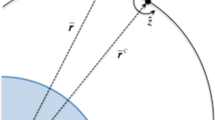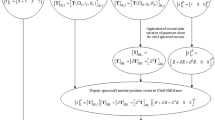Abstract
For on-orbit applications where two or more spacecraft are flying in close proximity, it is often convenient to apply the Clohessy-Wiltshire differential relative motion equations in order to calculate the relative motion of a deputy spacecraft about a chief spacecraft that is assumed to be in a circular orbit. Under these assumptions, the solutions to the Clohessy-Wiltshire equations can be re-parameterized as a set of relative orbital elements that fully characterize the relative motion of the deputy about the chief. In contrast to the Cartesian relative position and velocity states, relative orbital elements provide a clear geometric interpretation of the relative motion and yield an intuitive understanding of how the unforced relative motion will evolve with time. In this paper, the derivation of relative orbital elements is given, and the transformation between relative orbital elements and Cartesian state elements expressed in the local-vertical, local-horizontal frame is provided. The evolution of relative orbital elements with time is evaluated, and characteristics of the unforced motion in terms of relative orbital elements are described.









Similar content being viewed by others
References
Woffinden, D.C., Geller, D., Mosher, T., Kwong, J.: On-orbit satellite rendezvous inspection: a concept study and design. Spaceflight Mechanics 2005. Adv. Astronaut. Sci. 120(Parts 1 & 2), 849–867 (2005)
Sabol, C., Burns, R., McLaughlin, C.A.: Satellite formation flying design and evolution. J. Spacecr. Rocket. 38(2), 270–278 (2001)
Fasano, G., D’Errico, M.: Design of satellite formations for interferometric and bistatic SAR. Institute of Electrical and Electronics Engineers Aerospace Conference Paper No. 1064. Mar. 2007
Carreau, M.: NASA Approves Orbital Sciences for ISS Commercial Resupply Missions. Aviation Week and Space Technology. October 1, 2013
Clark, S.: Satellite In-Space Servicing Demo Mission a Success. Spaceflight Now. July 23, 2007
Malik, T.: Prototype Satellites Demonstrate In-Orbit Refueling. Space.com. April 4, 2007
Air Force Space Command: Resiliency and Disaggregated Space Architectures. White Paper, AFD-130821-034. August 21, 2013
Pawlikowski, E., Loverro, D., Cristler, T.: Space: Disruptive Challenges, New Opportunities, and New Strategies. Strateg. Stud. Q. 6(1), Spring (2012)
Jezewski, D.J., Brazzell, J.P., Prust, E.E., Brown, B.G., Mulder, T.A., Wissinger, D.B.: A Survey of Rendezvous Trajectory Planning. American Astronautical Society Paper, pp. 91–505. Aug. 1991
Gaylor, D.E., Barbee, B.W.: Algorithms for safe spacecraft proximity operations.. In: Conference Proceedings, Space Flight Mechanics 2007, Advances in the Astronautical Sciences, Vol. 127, pp 133–152 (2007)
Holzinger, M., DiMatteo, J., Schwartz, J., Milam, M.: Passively Safe Receding Horizon Control for Satellite Proximity Operations. In: Proceedings of the 47th IEEE Conference on Decision and Control, Cancun, Mexico. Dec. 2008
Breger, L., How, J.P.: Safe trajectories for autonomous rendezvous of spacecraft. J. Guid. Control. Dyn. 31(5), 1478–1489 (2008)
Roger, A.B., McInnes, C.R.: Safety constrained free-flyer path planning at the international space station. J. Guid. Control. Dyn. 23(6), 971–979 (2000)
Hill, G.W.: Researches in the lunar theory. Am. J. Math. 1(1), 5–26 (1878)
Tschauner, J., Hempel, P.: Rendezvous zu einem in elliptischer Bahn umlaufenden Ziel. Astronautica Acta 11(2), 104–109 (1965)
Clohessy, W.H., Wiltshire, R.S.: Terminal guidance system for satellite rendezvous. J. Aerosp. Sci. 27(9), 653–658 (1960)
Condurache, D., Martinuşi, V.: Relative spacecraft motion in a central force field. J. Guid. Control. Dyn. 30(3), 873–876 (2007). Engineering Notes
Schaub, H., Junkins, J.L.: Analytical Mechanics of Space Systems, AIAA. Reston, Virginia (2003)
Vallado, D.A. Fundamentals of Astrodynamics and Applications, 2nd. Microcosm Press, El Segundo, California (2004)
Kaplan, M.H.: Modern Spacecraft Dynamics & Control. John Wiley and Sons, New York (1976)
Gustafson, D.E., Kriegsman, B.A.: A guidance and navigation system for automatic stationkeeping in earth orbit. J. Spacecr. Rocket. 10(6), 369–376 (1973)
Vaddi, S.S., Alfriend, K.T., Vadali, S.R., Sengupta, P.: Formation establishment and reconfiguration using impulsive control. J. Guid. Control. Dyn. 28(2), 262–268 (2005)
D’Amico, S., Montenbruck, O.: Proximity operations of formation-flying spacecraft using an eccentricity/inclination vector separation. J. Guid. Control. Dyn. 29(3), 554–563 (2006)
D’Amico, S.: Relative Orbital Elements as Integration Constants of Hill’s Equations, DLR TN 05-08, December 15, (2005)
Gill, E., Montenbruck, O., D’Amico, S.: Autonomous formation flying for the PRISMA mission. J. Spacecr. Rocket. 44(3), 671–681 (2007)
D’Amico, S., Ardaens, J.-S., Gaias, G., Benninghoff, H., Schlepp, B., Jørgensen, J.L: Noncooperative rendezvous using angles-only optical navigation: system design and flight results. J. Guid. Control. Dyn. 36(6), 1576–1595 (2013)
Han, C., Yin, J.: Formation design in elliptical orbit using relative orbital elements. Acta Astronautica, 77. Aug.-Sept. 2012
Lovell, T.A., Tragesser, S.G.: Guidance for relative motion of low earth orbit spacecraft based on relative orbit elements. AIAA Paper. 2004–4988. Aug. 2004 D
Lovell, T.A., Tragesser, S.G., Tollefson, M.V.: A practical guidance methodology for relative motion of LEO spacecraft based on the clohessy-wiltshire equations. Am. Astronaut. Soc. Pap., 04–252 (2004)
Bevilacqua, R., Lovell, T.A.: Analytical guidance for spacecraft relative motion under constant thrust using relative orbit elements. Acta Astronautica 102, 47–61. September-October 2014
Phillips, M.: Spacecraft Collision Probability Estimation for Rendezvous and Proximity Operations. Master of Science Thesis, Utah State University, Logan Utah (2012)
Aubin, B.S: Optimization of Relative Orbit Transfers Via Particle Swarm and Primer Vector Theory. Master of Science Thesis, University of Illinois at Urbana-Champaign (2011)
Schwartz, J., Krenzke, T., Hur-Diaz, S., Ruschmann, M., Schmidt, J.: Error-Contracting Impulse Controller for Satellite Cluster Flight Formation. Paper AIAA 2013-4541, presented at the AIAA Guidance, Navigation, and Control Conference, Boston, MA. 19–22 August 2013
Schwartz, J., Krenzke, T., Hur-Diaz, S., Ruschmann, M., Schmidt, J.: The Flocking Controller: A Novel Cluster Control Strategy for Space Vehicles. Paper AIAA 2013-4543, presented at the AIAA Guidance, Navigation, and Control Conference, Boston, MA. 19–22 August 2013
Chait, S., Spencer, D.A: Prox-1: Automated Trajectory Control for On-Orbit Inspection. In: AAS 14-066, 37th Annual American Astronautical Society Guidance and Control Conference. January, 2014
Acknowledgments
The authors wish to acknowledge the following individuals who contributed to the development of the relative orbital element formulation: Steve Tragesser, Department of Aerospace Engineering, University of Colorado at Colorado Springs; Kenny Horneman, Barron Associates, Inc.; and Mark Tollefson, retired. The authors also acknowledge the United States Air Force Office of Scientific Research/Air Force Research Laboratory for their support of this work.
Author information
Authors and Affiliations
Corresponding author
Additional information
Thomas A. Lovell is a Research Aerospace Engineer, Space Vehicles Directorate, Air Force Research Laborabory; Associate Fellow, AIAA; Senior Member, AAS.
David A. Spencer is a Professor of the Practice, Guggenheim School of Aerospace Engineering, Georgia Institute of Technology, Atlanta, GA 30332-0150, Associate Fellow, AIAA, Member AAS.
Rights and permissions
About this article
Cite this article
Lovell, T.A., Spencer, D.A. Relative Orbital Elements Formulation Based upon the Clohessy-Wiltshire Equations. J of Astronaut Sci 61, 341–366 (2014). https://doi.org/10.1007/s40295-014-0029-6
Published:
Issue Date:
DOI: https://doi.org/10.1007/s40295-014-0029-6




